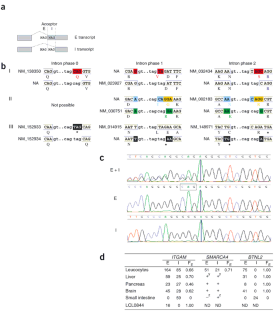Widespread occurrence of alternative splicing at NAGNAG acceptors contributes to proteome plasticity (original) (raw)
- Brief Communication
- Published: 31 October 2004
- Klaus Huse2 na1,
- Karol Szafranski2,
- Niels Jahn2,
- Jochen Hampe3,
- Stefan Schreiber3,
- Rolf Backofen1 &
- …
- Matthias Platzer2
Nature Genetics volume 36, pages 1255–1257 (2004)Cite this article
- 1280 Accesses
- 158 Citations
- 3 Altmetric
- Metrics details
A Corrigendum to this article was published on 01 January 2005
Abstract
Splice acceptors with the genomic NAGNAG motif may cause NAG insertion-deletions in transcripts, occur in 30% of human genes and are functional in at least 5% of human genes. We found five significant biases indicating that their distribution is nonrandom and that they are evolutionarily conserved and tissue-specific. Because of their subtle effects on mRNA and protein structures, these splice acceptors are often overlooked or underestimated, but they may have a great impact on biology and disease.
This is a preview of subscription content, access via your institution
Access options
Subscribe to this journal
Receive 12 print issues and online access
$209.00 per year
only $17.42 per issue
Buy this article
- Purchase on SpringerLink
- Instant access to full article PDF
Prices may be subject to local taxes which are calculated during checkout
Additional access options:
Figure 1: Alternative splicing at NAGNAG acceptors.

Similar content being viewed by others
References
- Garcia-Blanco, M.A., Baraniak, A.P. & Lasda, E.L. Nat. Biotechnol. 22, 535–546 (2004).
Article CAS Google Scholar - Long, M. & Deutsch, M. Mol. Biol. Evol. 16, 1528–1534 (1999).
Article CAS Google Scholar - Ferranti, P., Lilla, S., Chianese, L. & Addeo, F. J. Protein Chem. 18, 595–602 (1999).
Article CAS Google Scholar - Rogina, B. & Upholt, W.B. Biochem. Mol. Biol. Int. 35, 825–831 (1995).
CAS PubMed Google Scholar - Li, L. & Howe, G.A. Plant Mol. Biol. 46, 409–419 (2001).
Article CAS Google Scholar - Zhang, H.B. & Blumenthal, T. RNA 2, 380–388 (1996).
CAS PubMed PubMed Central Google Scholar - Sugnet, C.W., Kent, W.J., Ares, M. Jr. & Haussler, D. Pac. Symp. Biocomput. 2004, 66–77 (2004).
Google Scholar - Stamm, S. et al. DNA Cell Biol. 19, 739–756 (2000).
Article CAS Google Scholar - Ma, B., Elkayam, T., Wolfson, H. & Nussinov, R. Proc. Natl. Acad. Sci. USA 100, 5772–5777 (2003).
Article CAS Google Scholar - Chen, S., Anderson, K. & Moore, M.J. Proc. Natl. Acad. Sci. USA 97, 593–598 (2000).
Article CAS Google Scholar - Resch, A. et al. J. Proteome Res. 3, 76–83 (2004).
Article CAS Google Scholar - Condorelli, G., Bueno, R. & Smith, R.J. J. Biol. Chem. 269, 8510–8516 (1994).
CAS PubMed Google Scholar - Karinch, A.M., deMello, D.E. & Floros, J. Biochem. J. 321, 39–47 (1997).
Article CAS Google Scholar - Neves, G., Zucker, J., Daly, M. & Chess, A. Nat. Genet. 36, 240–246 (2004).
Article CAS Google Scholar - Zavolan, M. et al. Genome Res. 13, 1290–1300 (2003).
Article CAS Google Scholar
Acknowledgements
We thank I. Görlich and M.-L. Schmidt for technical assistance. This work was supported by grants from the German Ministry of Education and Research to S.S. and to M.P. as well as from the Deutsche Forschungsgemeinschaft to M.P.
Author information
Author notes
- Michael Hiller and Klaus Huse: These authors contributed equally to this work.
Authors and Affiliations
- Institute of Computer Science, Friedrich-Schiller-University Jena, Chair for Bioinformatics, Ernst-Abbe-Platz 2, Jena, 07743, Germany
Michael Hiller & Rolf Backofen - Genome Analysis, Institute of Molecular Biotechnology, Beutenbergstr. 11, Jena, 07745, Germany
Klaus Huse, Karol Szafranski, Niels Jahn & Matthias Platzer - Institute for Clinical Molecular Biology, Christian-Albrechts-University Kiel, Schittenhelmstr. 12, Kiel, 24105, Germany
Jochen Hampe & Stefan Schreiber
Authors
- Michael Hiller
You can also search for this author inPubMed Google Scholar - Klaus Huse
You can also search for this author inPubMed Google Scholar - Karol Szafranski
You can also search for this author inPubMed Google Scholar - Niels Jahn
You can also search for this author inPubMed Google Scholar - Jochen Hampe
You can also search for this author inPubMed Google Scholar - Stefan Schreiber
You can also search for this author inPubMed Google Scholar - Rolf Backofen
You can also search for this author inPubMed Google Scholar - Matthias Platzer
You can also search for this author inPubMed Google Scholar
Corresponding author
Correspondence toMatthias Platzer.
Ethics declarations
Competing interests
The authors declare no competing financial interests.
Supplementary information
Rights and permissions
About this article
Cite this article
Hiller, M., Huse, K., Szafranski, K. et al. Widespread occurrence of alternative splicing at NAGNAG acceptors contributes to proteome plasticity.Nat Genet 36, 1255–1257 (2004). https://doi.org/10.1038/ng1469
- Received: 06 September 2004
- Accepted: 06 October 2004
- Published: 31 October 2004
- Issue Date: 01 December 2004
- DOI: https://doi.org/10.1038/ng1469